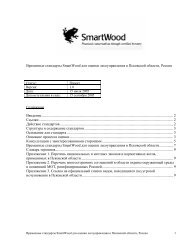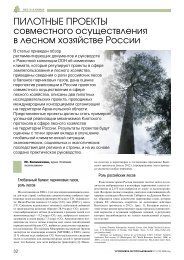Russia-China Timber Trade_cover.jpg
Russia-China Timber Trade_cover.jpg
Russia-China Timber Trade_cover.jpg
You also want an ePaper? Increase the reach of your titles
YUMPU automatically turns print PDFs into web optimized ePapers that Google loves.
second-level market have started to go to the first-level market to purchase timber. Thus, volumes at thesesecond-level markets have declined over the last couple of years.Dalian, located at the southern tip of the Liaodong Peninsula, has the largest ice-free port in northern <strong>China</strong>.Railways connect Dalian to Suifenhe and Manzhouli. <strong>Timber</strong> can be transported via ship to economically developedareas of eastern and southern <strong>China</strong>. Dalian was an important distribution centre in northeast <strong>China</strong> fordomestically-produced timber. Now <strong>Russia</strong>n timber accounts for about 80% of the total volume. When theDalian <strong>Timber</strong> Market was formally established in 1995, there was only one market, now it has expanded tothree markets. Before 2000, the volume of timber arriving to this market was 25,000 train wagons, equal toabout 1.5–1.7 million cu. m of timber. Recently, due to competition from first-level and some second-levelmarkets, the volume has been decreasing. According to estimates by local traders, yearly volumes have decreasedto about 1 million cu. m. In addition to import by rail, some timber is shipped to Dalian from RFE ports.But the amount totals just slightly more than 100,000 cu. m per year.Unlike at the Dezhou <strong>Timber</strong> Market, the processing industry near Dalian is quite developed. Finished products(such as furniture, floor, mouldings, etc.) and semi-finished products (such as sawnwood, laminated lumber,decorated veneers, etc.) are shipped to eastern, northern and southern <strong>China</strong>, and especially overseas. Accordingto rough statistics, the volume of sawnwood shipped to Shanghai, Shandong and Ningbo from Dalian in 2004,amounted to some 400,000, 200,000, and 150,000 cu. m, respectively. A small amount of timber entering Dalianwas not processed locally with the logs being shipped directly to port cities in eastern and northern <strong>China</strong>.Third-level timber marketsThird-level timber markets are small-scale retail markets that service the end users; they are scattered throughoutthe country. Most were set up in county government centres (townships) near second-level markets, somewere even established adjacent to second-level markets and undertake on-the-spot retail business after wholesalepurchase. All third-level timber markets process timber for the client, but the equipment is crude. Onlysemi-finished products can be processed.Processing of <strong>Russia</strong>n timber in <strong>China</strong>Most timber imported from <strong>Russia</strong> is processed within <strong>China</strong>. Although there are more than 200 enterprisesinvolved in the <strong>Russia</strong>n timber business, very few enterprises have established processing plants in <strong>Russia</strong>.According to statistics for <strong>Russia</strong>n timber imports in 2004, about 17.82 million cu. m of <strong>Russia</strong>n timber wasimported, of which, only 801,200 cu. m was sawnwood, representing only 4.5% of total import. There areapproximately three types of processing facilities in <strong>China</strong>. The first is on-the-spot processing in first-levelmarkets, the second is individual processing in the third retail markets, and the third is processing by end-users(including timber processing enterprises).Most enterprises that have the capacity to process logs are large and medium-sized furniture and buildingenterprises. These enterprises need large volumes of timber, they have abundant funds, and they possessadvanced milling and drying equipment. The timber processing mills set up in the timber markets do not meettheir quality standards.Processing at first-level marketsIn recent years, to develop the local economy, the governments of Suifenhe, Manzhouli and Erlianhot enthusiasticallyinvested in timber-processing zones. Suifenhe has made the most progress in this regard and has setup 4 timber processing zones: South <strong>Timber</strong> Processing Zone, Jianhua Processing Zone, Kuanxiang ProcessingZone, and Sunjiaxiang Processing Zone. These zones occupy an area of 3.37 sq. km and have 303 timberprocessing enterprises. Of these enterprises, 18 have an investment over 10 million RMB each. The totalannual processing capacity is about 3 million cu. m and drying capacity is 500,000 cu. m. In 2004, timberimports totalled 5.91 million cu. m; this means that 50% of <strong>Russia</strong>n roundwood could be processed on the spot.For the survey we conducted for this report we visited a number of processing enterprises. Some have theirown leased railway lines and modern processing equipment, including equipment from Japan, Italy, Germanyand Taiwan Province.They have an annual processing capacity of between 100,000 and 300,000 cu. m. The number of employeesfor each enterprise was 300 to 400. The products include square-edged lumber, laminated lumber, flooringblocks, sawn and peeled veneer, decorative moulding, semi-finished furniture and solid-wood (Scotch pine)dining tables and chairs. Currently most products are semi-finished products as higher-end products are stillonly produced in small amounts.23

















